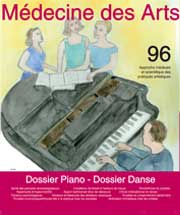Revue Médecine des Arts N°96 The pianist's health - The dancer's health

Revue Médecine des Arts N°96 The pianist's health - The dancer's healthArtists' health, musician's health
Issue 96. Artists' health: dossier on the health of pianists, dossier on the health of dancers
Medical and scientific approach to artistic practices
Free Shipping
The articles of the journal are not sold independently, the price of 17 euros corresponds to the price of the whole magazine, all articles and chronicles.
The health of the pianist is the subject of a special report on the health of the accompanying pianist: a qualitative study explores the world of these musicians in relation to their health, and on musculoskeletal disorders in pianists: prevalence and risk factors are presented on the basis of several studies on this theme. A number of articles on pianists' health round off this issue, including rhizarthrosis in pianists, agenesis of the extensor pollicis brevis in a pianist, and hyperlaxity in pianists.
This issue also features a dance dossier with numerous articles and abstracts on dancer's health, nutrition, low back pain, sleep, foot and ankle injuries, dental occlusion and postural balance, etc.
An article on the motivation of high-level musicians rounds off issue 96.
Which of the two is the theater?
AbstractThe performance is also in the auditorium and among the spectators. My first experience of a live musical performance was at the Mariinsky Theatre in Saint Petersburg,’ Stravinsky (then aged seven or eight) recounts.... I was stunned by the spectacle of the theatre itself and of the audience...
Find out more in issue 96 ...
Professional practice and the health of piano accompanists
AbstractPiano accompanists work in a wide variety of professional contexts. This qualitative study based on semi-directive interviews was conducted to explore the world of these musicians in relation to their health. Fourteen piano accompanists were interviewed (8 women and 6 men), with an average age of 45 (10 of them between 30 and 50). Eleven accompany singers, 7 accompany choirs, 5 accompany instrumentalists, 4 accompany dancers, and 2 play 4-handed. Most have civil servant or salaried status, and some combine several part-time statuses. They were questioned about their working conditions: workplaces, daily commutes, sound and visual environment, perception of workload, etc., as well as their physical and psychological condition and health.
For piano accompanists, the difficulties of their profession are largely offset by their passion for a job they find stimulating. Musculoskeletal disorders are common, but accompanists usually attribute them to causes other than their musical practice. They do, however, point to risky practices such as accompanying dancers or 4-handed playing. All wear optical corrections, and visual aspects are very important to them. They are aware of the risk of hearing damage, especially traumatic damage, but do not wear hearing protection, despite the preventive measures taken by some institutions. They report many stressful situations.
The specific musical, technical, cognitive and interpersonal skills of accompanying pianists, as well as their working conditions, may have an impact on their health. These specificities should be taken into account by their partners, the music establishments and their caregivers.
Key words: piano accompanist; pianist; health; working conditions; interview
Music-related musculoskeletal disorders in pianists: prevalence and risk factors
AbstractDossier : The pianist's health
AbstractPianists‘ health: Rhizarthrosis in pianists, agenesis of the extensor pollicis brevis in pianists, hyperlaxity and hypermobility in pianists are covered in this dossier on pianists’ health.
Dossier dancer's health
AbstractNutritional intake and energy expenditure in dance, Eating disorders in dancers, Psychological aspects of eating behaviour in dancers, Depression, anxiety and eating disorders in professional dancers, The motivational climate and its impact on the health of ballet dancers, Low back pain and sciatica in ballet dancers, Foot and ankle injuries in ballet dancers, Morning or evening training: What influence on dancers' sleep, Low back pain in dancers, Dental occlusion and neuromuscular behaviour in classical dancers, Multimodal sensory integration and recovery of trained motor patterns for body coordination in musicians and dancers, The mechanisms of groove. All the scientific articles covered in this dossier
Reaching the very highest level in your discipline. What comes next?
AbstractIn childhood, all musicians, whatever their subsequent career choice, develop strong skills, but some use them to reinforce their autonomy and get ahead, whereas the musician who enjoys having a better level than others from a very early age remains attached to external factors such as comparing performance levels with others.
Portrait of the artist as a worker. N°96
AbstractNumerous testimonials from artists about their artistic practice, whether musician, singer, actor or dancer. They reveal how they live their lives as artists.
Version papier
17€
Les garanties médecine des arts
Articles en stock
Envoi dans les 24h
Paiement
en ligne sécurisé
Une question ?
